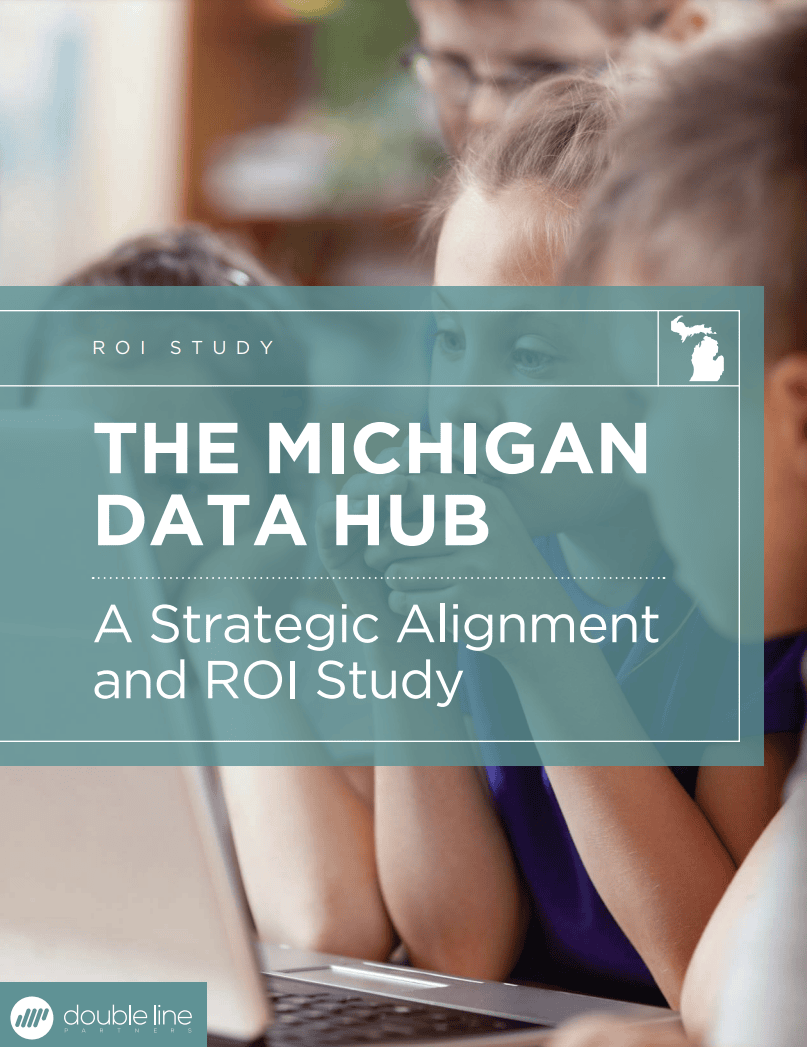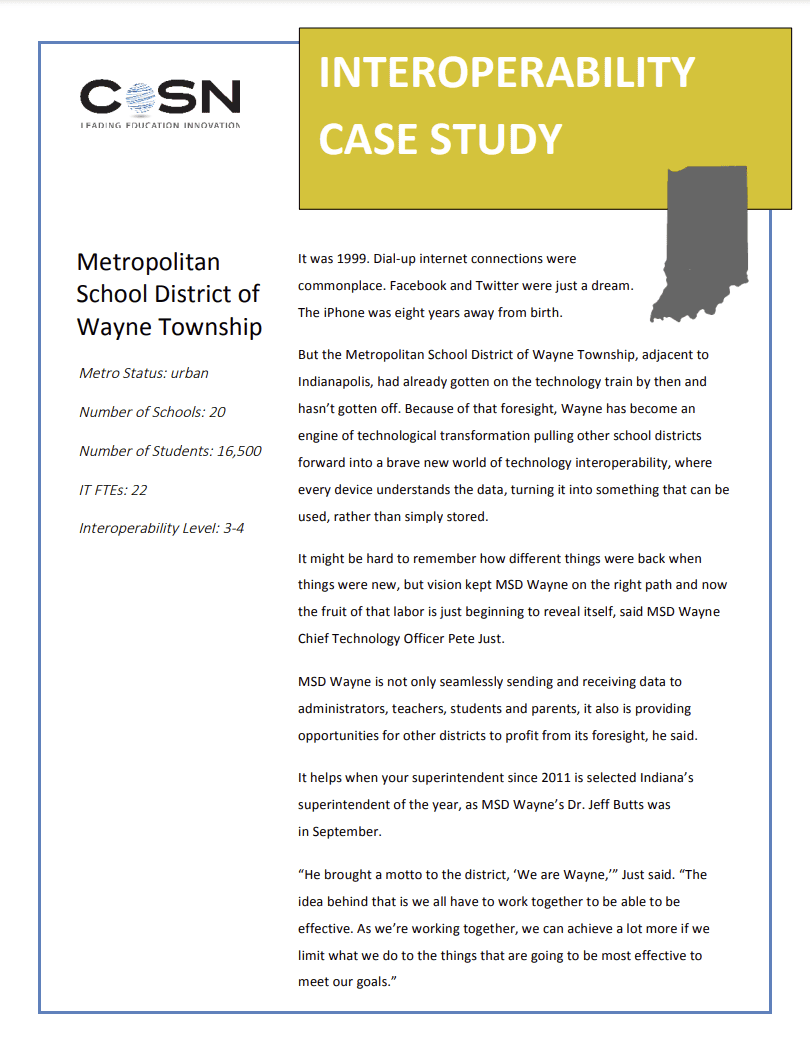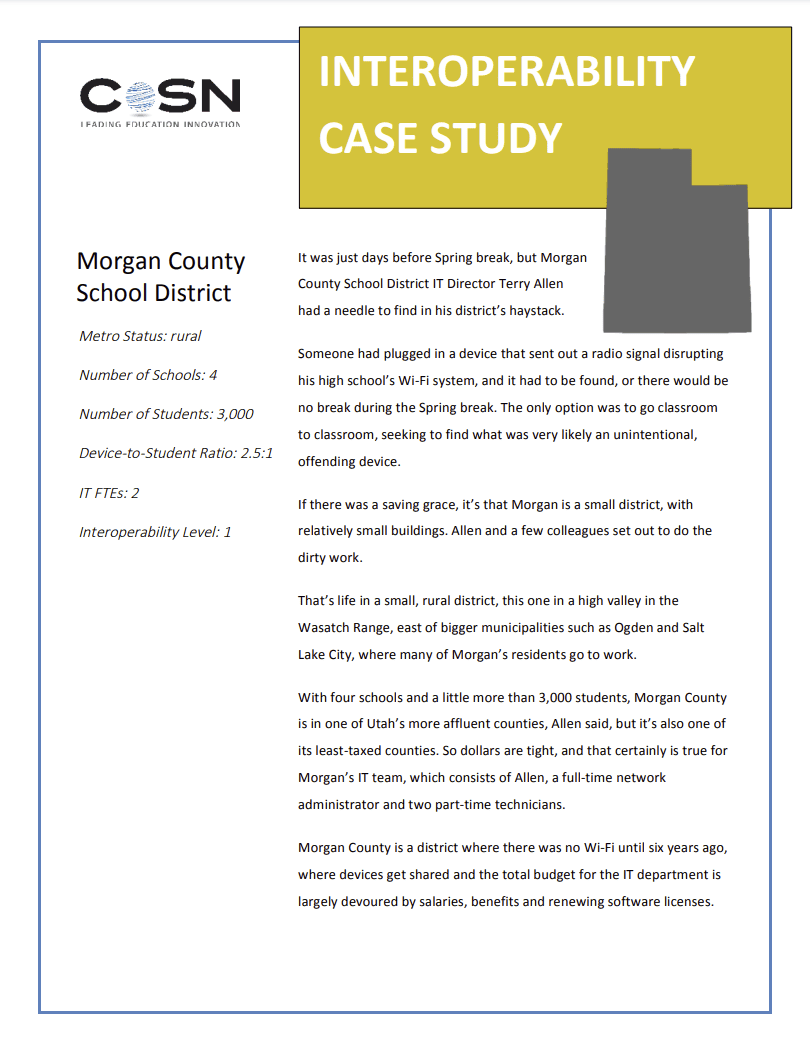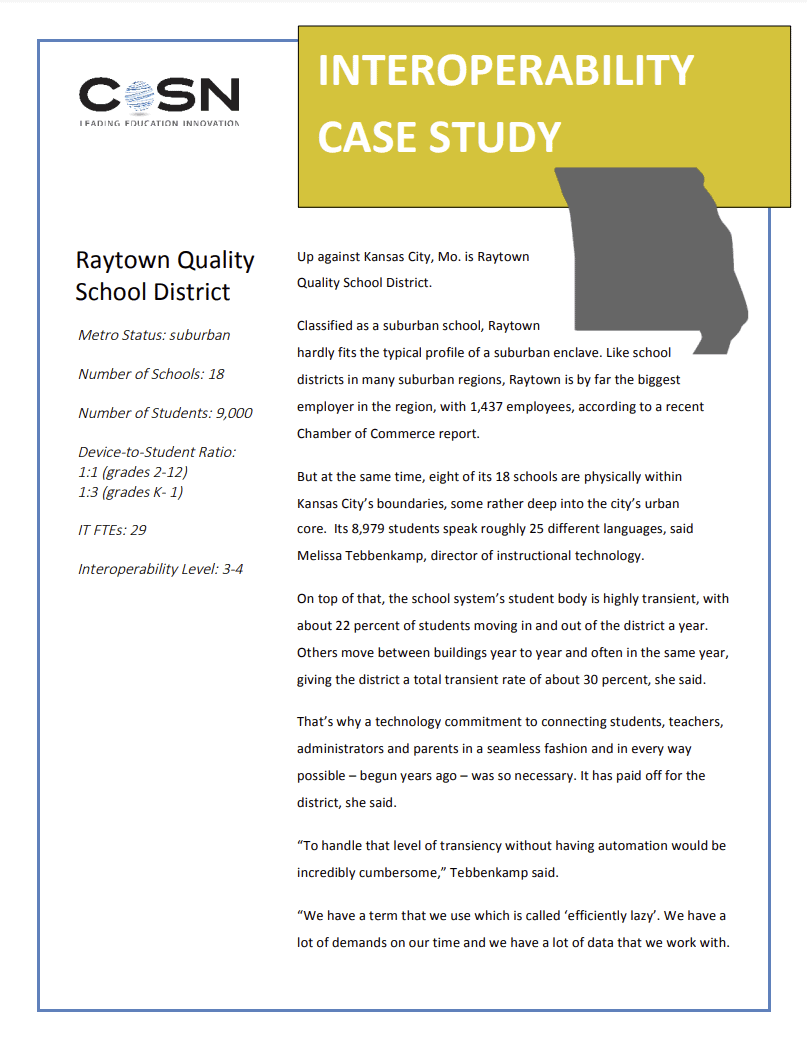Interoperability Toolkit
K–12 education institutions are increasingly looking to digital content and related e-learning technologies to meet evolving education needs and goals. Technology-based products, services, and resources are making positive impacts on education and are improving efficiency and outcomes in teaching, learning, and classroom and school management. And yet, as educators grow more sophisticated in their use of technology, there are gaps in the integration and interfaces among disparate applications. CoSN has developed this Interoperability Toolkit to help districts increase the interoperability of their academic and operational systems.
CoSN Interoperability Project Director: Paula Maylahn, pmaylahn@cosn.org.
CoSN staff contact: Keith Krueger, MPA, CAE, CEO, kkrueger@cosn.org.
Maturity Model
A key step to developing and implementing an interoperability plan is identifying a district’s current interoperability status. Use this interactive Interoperability Maturity Model to determine where your district sits across 6 domains, then navigate through the identified next steps to achieve your goals.

Cost Calculator
The effort needed to connect siloed systems is expensive and time-consuming. CoSN has two NEW tools to help IT leaders estimate the cost of integrating platforms that were not developed using open standards, into their digital ecosystems.
The spreadsheet template allows for customization while the online question-based tool doesn’t require any spreadsheet skills. Both tools can be used as part of the vetting process for a new system or to estimate costs of existing system pairings that are not interoperable. We hope the ability to generate ballpark estimates will help IT Leaders talk to other education stakeholders and vendors about the impact siloed systems have on their district’s budgets.
Standards
K-12 education hasn’t focused on interoperability—the seamless sharing of data content and services among systems and applications. To address this issue, CoSN created An Introduction to Interoperability Standards for Education Leaders to help district leaders understand why interoperability standards matter.
RFPs
When preparing an RFP for a new classroom or enterprise management system, CoSN recommends that the degree to which the system interoperates with other systems be the main criterion. To facilitate this effort, CoSN has created a guide for preparing interoperability requirements and communicating your district’s needs to providers.
Interoperability Case Studies
The map of interoperability has many possible routes, regardless of where you start your journey. CoSN interviewed three IT Leaders, representing the various stages of the Interoperability Maturity Model, to learn what paths they took to increase the level of interoperability of their academic and operational systems. We hope these real-world examples can help you get to where you want to go.

The Michigan Data Hub: A Strategic Alignment and ROI Study
An eye-opening glimpse into a statewide impact of siloed systems and their impact on district budgets.
The State of Michigan is committed to becoming a top 10 education state in the next 10 years. Achieving that vision will require the efforts of an entire educational enterprise that spans from the classroom up to the State of Michigan and includes every entity in-between. As leaders of several of those entities, we recognize both the importance of data in improving educational outcomes and the difficulties that are involved in getting timely, accurate and actionable data from the myriad of data systems in use statewide.
Metropolitan School District of Wayne Township
It was 1999. Dial-up internet connections were commonplace. Facebook and Twitter were just a dream. The iPhone was eight years away from birth. But the Metropolitan School District of Wayne Township, adjacent to Indianapolis, had already gotten on the technology train by then and hasn’t gotten off. Because of that foresight, Wayne has become an engine of technological transformation pulling other school districts forward into a brave new world of technology interoperability, where every device understands the data, turning it into something that can be used, rather than simply stored. (2021)


Morgan County School District (UT)
It was just days before Spring break, but Morgan County School District IT Director Terry Allen had a needle to find in his district’s haystack. Someone had plugged in a device that sent out a radio signal disrupting his high school’s Wi-Fi system, and it had to be found, or there would be no break during the Spring break. The only option was to go classroom to classroom, seeking to find what was very likely an unintentional, offending device.
Raytown Quality School Dristrict (MO)
Up against Kansas City, Mo. is Raytown Quality School District.
Classified as a suburban school, Raytown hardly fits the typical profile of a suburban enclave. Like school districts in many suburban regions, Raytown is by far the biggest employer in the region, with 1,437 employees, according to a recent Chamber of Commerce report.

Featured Resources
Discussion Tools
It can be difficult for IT Leaders to explain the importance of interoperability to education leaders who don’t have a technology background. To help address this issue, CoSN has created a flyer designed for superintendents and a slide deck with components that can be imported into your own presentation and customized for any audience.
Interoperability is Finally Getting the Spotlight it Deserves
By Chloe Sanducci
Interoperability is the seamless, secure, and controlled exchange of data between applications. Implementing interoperability can bring information from EdTech tools together to holistically contextualize student learning, allowing educators, schools, and districts to understand their students better and support their paths to graduation. Executing data interoperability standards creates a modern data infrastructure by supporting improved development, privacy, and cybersecurity practices while ensuring compliance with industry best practices.
Additional Resources
CoSN is not the only organization providing free resources designed to facilitate meaningful discussions with education stakeholders about interoperability! Additional resources for explaining interoperability and why it’s important:


